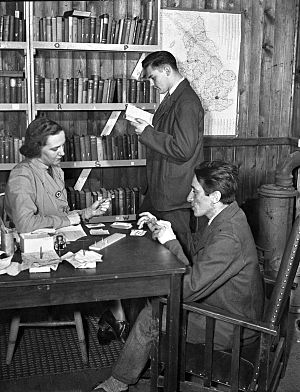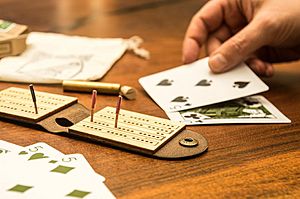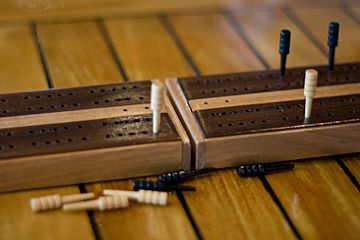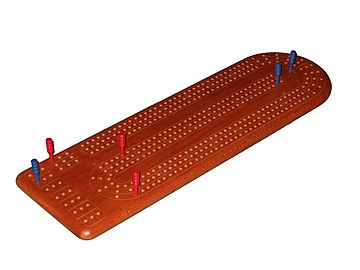Cribbage facts for kids
 |
|
| Origin | England |
|---|---|
| Alternative names | Crib |
| Family | Matching |
| Players | 2 (variations for 3–6) |
| Skills required | Strategy, tactics, counting |
| Cards | 52 |
| Deck | Standard 52-card pack |
| Play | Clockwise |
| Card rank (highest to lowest) | K Q J 10 9 8 7 6 5 4 3 2 A |
| Playing time | 15–30 min. |
| Related games | |
| Noddy • Costly Colours | |
Cribbage, also known as crib, is a fun card game usually played by two people. It involves playing and grouping cards to earn points. You can also play it with three or four players.
Cribbage is special because it uses a unique board to keep score. It also has a special set of cards called the crib or box. The game has two main scoring parts and a unique way to score points, especially for groups of cards that add up to 15. Many people call it "Britain's national card game."
The game has simple rules but many clever tricks and strategies. This is why people love playing it so much. How you play depends on your opponent's cards and your own position on the board. A game can be won by just one point. Experienced players often win by using smart strategies and calculating their chances.
Contents
History of Cribbage
Cribbage was invented in the early 1600s by an English poet named Sir John Suckling. It came from an older game called "noddy". While noddy is rarely played today, cribbage is still very popular. People who speak English especially enjoy it.
The main goal of cribbage is to be the first player to reach a certain score, usually 61 or 121 points. You score points for different card combinations. These include cards that add up to 15 or 31, pairs of cards, and sequences of numbers.
The first rules for cribbage were written down in England in the mid-1600s. The famous writer Charles Dickens helped make the game even more popular. He wrote about cribbage in his book The Old Curiosity Shop.
Cribbage was also popular among gold miners in the American West. There's even a small town in Montana called Nelson that calls itself the "Cribbage Capital of the World"! American submarine sailors also love playing cribbage. The oldest active submarine in the United States Pacific Fleet carries a special cribbage board. It belonged to a World War II submarine commander.
How to Play Cribbage
A game of cribbage has several "hands." Each hand includes dealing cards, playing cards, and showing your hand to score. If a player reaches the target score (like 121 points) at any time, they win immediately!
Dealing the Cards
Players first pick cards to see who deals. The person with the lowest card deals first. The dealer shuffles the cards. For two players, each gets six cards. For three or four players, each gets five cards.
After getting your cards, you choose four cards to keep. You then discard the other one or two cards face-down. These discarded cards form the "crib" or "box." The dealer will use these cards later.
Next, the player to the dealer's left cuts the remaining deck. The dealer then turns over the top card of the cut deck. This is called the "starter card" or "cut." If this card is a jack, the dealer immediately scores two points. This is called "his heels" or "his nibs."
Playing the Cards
Starting with the player to the dealer's left, players take turns playing one card face up. As you play a card, you say the total count of all cards played so far. For example, if the first player plays a five, they say "five." If the next player plays a six, they say "eleven" (five plus six). The total count cannot go over 31. Face cards (kings, queens, and jacks) count as 10 points.
Players score points during this part of the game:
- 15 points: If your card makes the total count exactly 15, you score two points.
- Pairs: If you play a card that matches the rank of the last card played, you score two points for a pair.
- Three of a kind (like three 7s) scores six points.
- Four of a kind (like four 7s) scores 12 points.
- Runs: If your card creates a sequence of three or more cards (like 4, 5, 6), you score points for the number of cards in the run. The cards don't have to be played in exact order.
If a player cannot play a card without the count going over 31, they say "Go." The other players continue playing until no one can play. If the count is still under 31, the player who played the last card scores one point. If the count is exactly 31, they score two points. The count then resets to zero. Players with cards left continue playing until all cards are played.
Players try to play their cards in a way that gets them the most points. This is called "pegging." If a player reaches the target score, they win the game right away.
Showing Your Hand
After all cards are played, players show their hands. They score points based on their four cards combined with the starter card. The player to the dealer's left scores first.
Here's how you score points:
- Fifteen: Any combination of cards that adds up to 15 scores two points.
- Runs: Three or more cards in a sequence (like 7, 8, 9) score points for the number of cards in the run.
- Pairs: Two cards of the same rank score two points.
- Four-card flush: If all four cards in your hand are the same suit, you score four points.
- Five-card flush: If all four cards in your hand and the starter card are the same suit, you score five points.
- Jack for his nob: If you have a jack in your hand that is the same suit as the starter card, you score one point.
The dealer scores their hand last. Then, the dealer turns over the cards in the crib. The dealer scores these cards as an extra hand, also using the starter card. The crib cannot score a four-card flush, but it can score a five-card flush.
It's interesting to know that you can score any number of points from 0 to 29, except for 19, 25, 26, and 27. If a hand scores zero points, players sometimes jokingly call it a "nineteen hand."
Muggins Rule
"Muggins" is an optional rule. If a player forgets to claim all their points during a turn, the opponent can say "Muggins" and take those forgotten points for themselves! This rule must be agreed upon before the game starts.
Match Play
Sometimes, people play a "match" which means playing more than one game. Match points are scored on the cribbage board too. Usually, winning a game gives you one match point. If you "skunk" your opponent (reach 121 points before they reach 91), you might get two match points. There are different ways to score match points, but these are often optional rules.
The Cribbage Board
The cribbage board is a very famous part of the game. It's a board with many holes where players keep score using small pegs. While you could use paper, the board is almost always used because you score points throughout the game.
Players use two pegs to keep track of their score. They move one peg ahead of the other. This way, if you get confused while counting points, the second peg still shows your previous score. Some boards also have extra holes to count how many games each player has won.
There are different types of cribbage boards:
- Most classic boards are flat wooden rectangles. They have two rows of 60 holes, divided into sections of five points.
- Some older boards are shaped like triangles with rows of holes on each side.
- Newer boards often have three or four rows of 120 holes, shaped like a paperclip. These are great for games played to 121 points.
- Another cool design is shaped like the number 29. This is because 29 is the highest possible score in a single hand!
Each 30-point section on the board is sometimes called a "street." So, if you are at 15 points, you are on "first street." If you are at 59 points, you are on "second street."
Related Games
Cribbage came from an older game called noddy. Noddy was played with only three cards and had similar scoring. Another related game is Costly Colours. This game also uses three cards and has similar scoring for "points." It also adds points for having cards of the same suit, called "colours."
See also
 In Spanish: Cribbage para niños
In Spanish: Cribbage para niños
- Hounds and Jackals, an ancient Egyptian game with a similar board.
- Kings Cribbage, a game where cribbage hands are built like a crossword puzzle.
Images for kids







